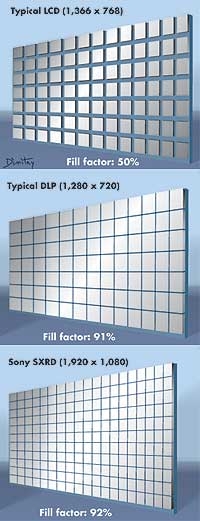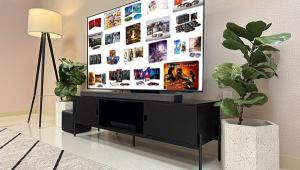Object of Desire Page 5
|
The SXRD chip's architecture isn't radically different from other LCoS devices we've seen. The two biggest achievements are Sony's refinements of that design and advances said to allow SXRD chips to be manufactured in quantity.
To date, TV manufacturers have made few attempts at consumer displays capable of full HDTV resolution of 1,920 x 1,080 pixels. That's about to change - several companies announced models at this year's Consumer Electronics Show (click to see "CES Showstoppers"). Among the three prominent microdisplay technologies, Texas Instruments' DLP has shown promise but has been limited to 1,280 x 720 pixels - about 33% less detail than the highest-quality HDTV signal. Only recently has TI released a chip for consumer TVs capable of full HD resolution, and we expect to evaluate HDTVs with that chip in future issues.
Between the remaining technologies, LCD and LCoS are both based on liquid crystals and have been used for 1,920 x 1,080 chips or panels. LCDs use backlighting that shines through transparent pixels to make the picture, but they require dark areas between the pixels, usually to hide each pixel's electrical connections. The wasted space requires a larger chip to achieve any given resolution compared with a typical DLP or LCoS device, and this in turn contributes to the "screen door" effect of a visible grid structure when the image is viewed close up. The required thickness of the liquid-crystal layer in a typical LCD TV also affects response time, creating the potential for blurring or for trails on fast-moving objects when the display can't keep up with changes in the signal.
By comparision, LCoS panels are reflective. Light passes through a liquid-crystal layer sandwiched between a pair of alignment layers before hitting a "backplane" that bounces it back through the same trio of layers and on toward the screen. Since no backlighting is required, electrical connections are hidden behind the backplane, and the pixels can be placed closer together. In fact, Sony claims to have reduced the dead space between pixels on its SXRD chips to 0.35 micrometer - one-tenth of the space on its own LCD displays. The pitch, or distance from the middle of one pixel to that of the next, measures just 9 micrometers (about 1 / 8 the width of a human hair).
Each SXRD chip has 1,920 x 1,080 pixels, for full 1080p resolution - something few TVs can claim. The chips themselves are tiny - about 3/4 of an inch across - and according to Sony the pixels are packed tighter than on any microdisplay to date. It's this high density, not just the number of pixels, that's unique and contributes to a more filmlike display.
Also, since the light in an LCoS chip passes through the same layers twice , the thickness of the liquid-crystal layer can be reduced compared with an LCD device. This allows faster r esponse time and less light loss, which improves contrast. Sony attributes SXRD's quick response time - claimed to be 5 milliseconds, much faster than other liquid-crystal technology - to a very thin liquid-crystal layer of just 2 micrometers. This is said to be even thinner than a traditional LCoS chip. The inherent boost in contrast is further enhanced by Sony's use o f Vertically Aligned, or untwisted, crystals, which naturally d isplay black and therefore make it easier to achieve deeper blacks onscreen. Most LCD displays use Twisted Nematic crystals, which begin in a twisted state and naturally display white.
Sony declined to explain the details behind its proprietary processes for getting the crystals so thin or for overcoming the manufacturing difficulties that plagued previous LCoS designs. But the result, the best rear-projection microdisplay image I've seen yet, is no secret. - D.K.














































